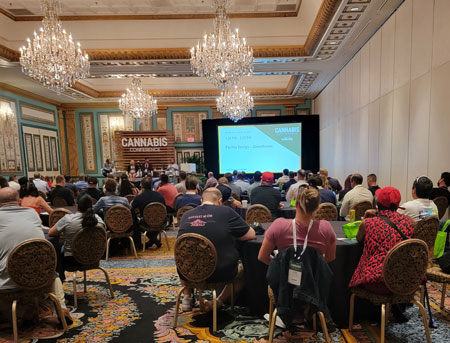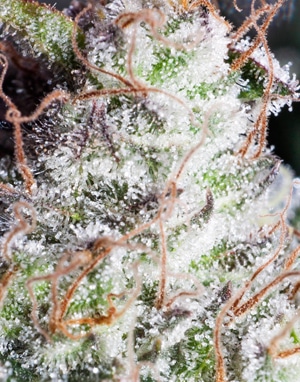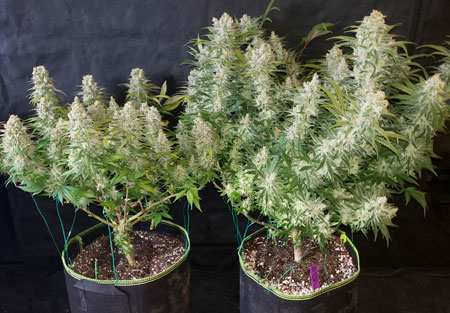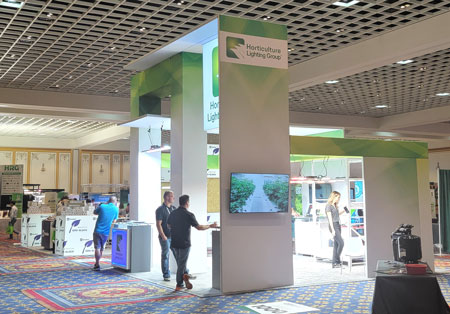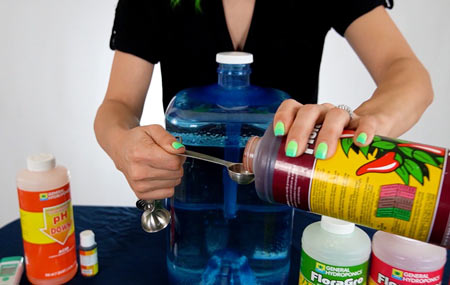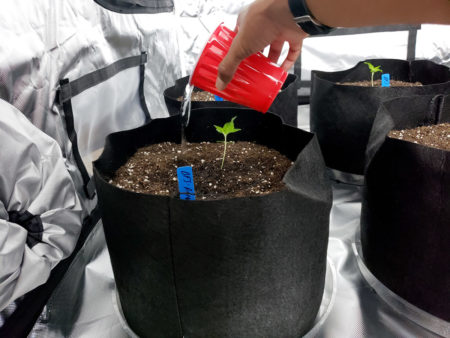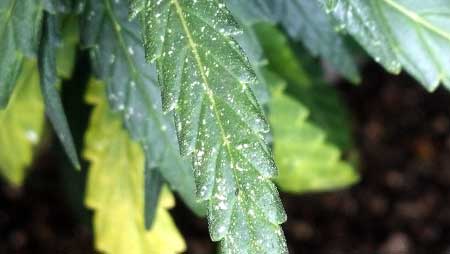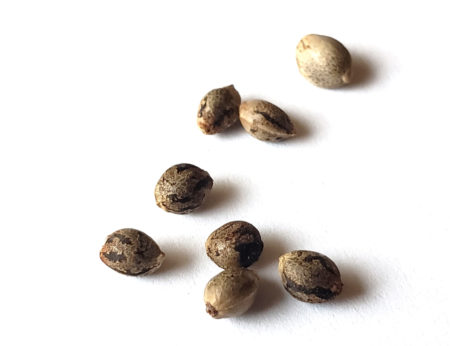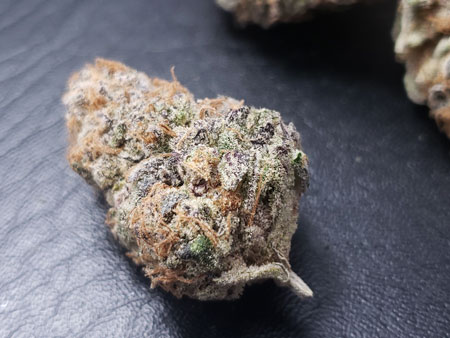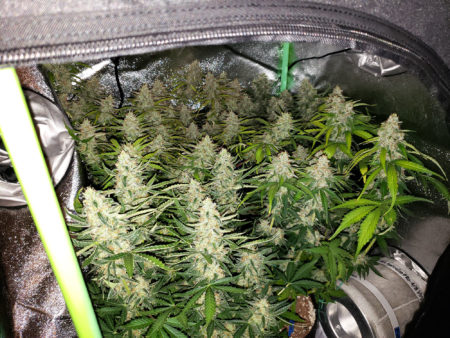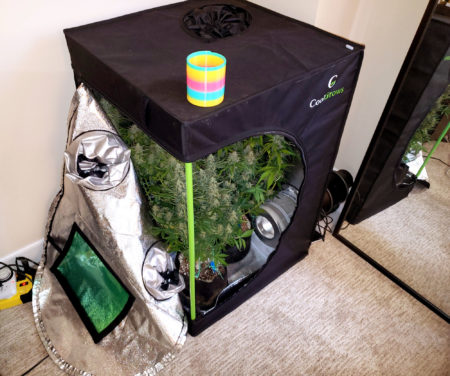Updated 9/13/2023 to add links to the new cannabis hop latent viroid and beet curly top virus pages.
by Nebula Haze
My partner Sirius and I (we run GrowWeedEasy.com) recently attended the Cannabis Conference in Las Vegas in August 2022. This enormous annual marijuana event featured hundreds of plant-touching cannabis businesses and involved 3 days of classes about numerous subjects related to running a cannabis business or grow operation. With so many talented growers under one roof sharing their knowledge and experience, I knew I had to attend. I was certain I’d learn new cannabis-growing discoveries by industry growers and be able to share the latest knowledge with home growers who unfortunately rarely get access to that kind of information.
I sat through 3 days of classes and talked to scores of growers so you don’t have to. The Cannabis Conference happens every year and is one of the biggest cannabis conferences in the world.
I’m so glad we went because I learned a lot. I confirmed theories and dispelled myths. Anyone who reads our weekly newsletter knows that we run a lot of side-by-side home growing experiments and I’m excited to learn that commercial growers are getting many of the same results as us.
So without further ado, I’d like to share some of the most significant information I learned that is relevant to home growers. This knowledge will help you take your cannabis garden to the next level because the fact is, home growers can produce better cannabis buds than a dispensary if they have the right information and use the right equipment.
1.) THC or CBD Percentage – How do you increase it?
This is something we’ve been testing lately at GrowWeedEasy.com, and findings from commercial growers seem to nearly all agree with our results.
How are growers increasing the percentage of THC and other cannabinoids in their buds?
This seems to be the overwhelming consensus when it comes to increasing THC and other cannabinoids:
- #1 Factor is genetics – a plant can only produce as much THC or CBD as its genetic potential. In order to produce high-THC or high-CBD. This is pretty standard knowledge, but the growers I spoke to re-iterated this over and over.
- Light intensity is key – Higher light intensity is associated with higher THC in buds (unfortunately I wasn’t able to confirm whether this is true for CBD). This confirms recent findings we’ve had in our side-by-side experiments.
- THC levels are greater on the buds higher up on the plant – I have found this to be true, but I thought it was because buds near the top get more light. I spoke with one grower who had been conducting tests. He explained they used supplemental side lighting to determine if they could get lower buds to produce as much THC as upper buds, but the location of the buds still had an effect. Even if the lower buds got the same amount of light, the upper buds were still more potent in lab tests. I got this information from just one grower, so I’d take this with a grain of salt for now. But this is definitely an area I plan to investigate further with lab testing.
- Light type makes a difference – HPS vs LEC vs LEDs can all affect cannabinoid percentages even if everything else is the same. However, more study is needed, as different strains seem to respond best to different light types. HPS is consistent for producing high cannabinoids, LEC is relatively consistent for producing higher terpenes, and LEDs vary greatly depending on the particular model, form factor, and spectrum.
- Light spectrum makes a difference – I already suspected this from previous tests. For example, whenever I grow with HLG R-spec lights, I seem to get higher levels of THC than growing those strains under some other types of lights. At the conference, I had multiple growers confirm light spectrum makes a difference to cannabinoid production. The problem…. it depends on the strain. For example, some strains tend to produce higher levels of THC but lower yields if they receive a lot of far-red in the light spectrum. But other strains get lower yields without the increase in THC. Part of why this can be such a confusing topic to test is that every strain is different. We will definitely be investigating this in more detail.
- Strategic defoliation in the flowering stage seems to increase THC percentage – We recently found this ourselves in a defoliation side-by-side experiment, but I had this idea confirmed by more than one grower. Every major commercial grow operation I spoke to uses defoliation in the flowering stage as part of their plant care.
- Stress the last 1-2 weeks before harvest seems to increase THC – Many growers I spoke with have a strategy of trying to keep plants perfectly green and healthy until about 2 weeks before harvest. Then growers do things like lower the humidity below 40% RH, increase air circulation to the point that branches may start waving around a little (not too much as too much wind can damage trichomes), and other stressors to improve bud quality, increase the amount of purple, and potentially increase THC. We recently ran an experiment on a 3-day dark period before harvest, which found that the THC seemed to increase after plants were left in the dark for 3 days, though it was a last-minute experiment without a clone as a control plant. We will be doing another experiment on the 3-day dark period with clones, and after the conference, probably be testing other types of pre-harvest stress as well. However, too much stress will hurt yields and may discolor or damage buds (no one wants brown burnt buds), so it’s important to be strategic and avoid going overboard.
I thought this was interesting and possibly worth looking into:
- Buds that get too big may “dilute” the cannabinoid percentage – A plant biologist conducted experiments with light intensity. He kept increasing light levels while keeping cannabis plants healthy. He found higher light levels increased THC and yields… to a point. After a certain amount of light, the percentage of THC actually started going down in buds even though the yields continued to increase. He suspected that this is due to dilution. It makes me wonder… could it actually be that too much light is the culprit? Or is he right that buds reach a point where they’re making more mass but not more THC? And if it’s that the buds are getting too big, what is the “ideal” size of buds, and does that vary from strain to strain? So many questions…
Does it decrease THC percentage if buds get too big? It’s possible…
2.) Yields – How do you increase it?
Every cannabis grower wants the best yields. What have growers discovered about improving yields when it comes to cannabis plants?
Here’s what I learned:
- Strategic defoliation increases yields – When I started growing weed and first heard about strategic flowering stage defoliation, the idea of defoliating cannabis plants can increase yields was widely debated. There were a lot of people saying, “That doesn’t make sense” because the plant uses leaves to make energy. But when I tried defoliating for the first time, it was obvious to me that it increased not just the total yields but also the overall bud tightness and quality. No doubts anymore. Multiple growers I talked to had done side-by-side experiments with defoliation as part of their grow operations. They found that it increased yields by up to 20% as well as increased bud quality, THC percentage, and made it easier to process plants after harvest. I also learned that commercial grow operations typically defoliate on week 3 and 6 of the flowering stage (as opposed to week 0 and 3 as I’d been taught). I will certainly try their defoliation schedule next time.
- Spectrum affects yields, but we haven’t gotten it down to a science yet – Some cool tidbits:
- You need lots of red for the best yields – It is pretty widely known that having a lot of red in your light spectrum increases bud yields, but it was nice to hear it confirmed by growers who did experimentation. It’s still up for debate the exact amount of red and which specific wavelengths of red are best for yields, but it’s well established that a relatively high amount of red is important to get the best yields.
- Too much red may decrease yields – Giving plants excessive amounts of red in the flowering stage seems to decrease yields, though in some plants increased THC percentages. Unfortunately, there’s still a lot we need to know to understand spectrum.
- Far-red contributes to photosynthesis, which has huge implications – When growers talk about light, they often talk about PAR (photosynthetically active radiation), which describes the range of light between 400nm (blue) to 700nm (red). The range of 400-700nm was believed to be the spectra of light that contributed significantly to photosynthesis in plants. However, there is new evidence from NASA that some light outside the typical PAR range (specifically far red up to 750nm) contributes directly to photosynthesis. It used to be believed that far-red had signaling properties, but was not photosynthetically active and therefore not measured as part of PAR. This is why Dr. Bruce Bugbee, the Professor of Crop Physiology at Utah State University and the President of Apogee Instruments (which makes high-tech grow equipment including laboratory-level light meters) has started calling the range of light between 400-750 nm “ePAR” to differentiate from what we used to think of as PAR. And that’s why Apogee now offers ePAR light meters that go up to 750nm. This is an area of study I plan to research much further in the upcoming months.
There were several grow light companies at this conference, but I was blown away by the HLG booth. These guys take LEDs seriously and seem to care far more about cannabis home growers than any other LED company. While other LED companies lost interest when I mentioned I focus on home growing, the guys at HLG actually seemed more interested. They wanted to learn how to better serve the unique needs of home growers. On top of that, HLG tests their LED grow lights on actual plants and have developed a new LED form factor (coming out soon) that they’ve found significantly increases yields. It’s never been a more exciting time to be a grower.
I can’t wait to try the new LED grow lights that are coming out soon from HLG (Horticulture Lighting Company).
3.) No one talked about nutrient brands or special grow supplements
In the home-growing world, growers are obsessed with choosing the best nutrients and supplements. So I expected there to be a lot of growers talking about which nutrients and supplements work the best for growing cannabis.
However, in the entire 3-day conference, I didn’t hear a single grower talk about the need to use specific brands of nutrients or supplements. Their only concern with nutrients was to prevent nutrient deficiencies and ensure fast healthy growth. As long as leaves were a nice healthy green and plants were growing at a brisk pace, nearly all their efforts were aimed at improving the environment (especially temperature, humidity, air circulation, and light) to increase results, as opposed to the specific nutrient source. One grower told me that special nutrients and supplements are aimed at small-scale and home growers because they don’t have the ability to conduct real tests. Once growers start operating on large scales, they quickly realize that most nutrients performed similarly and so they just went with whatever was the cheapest one that seemed to produce healthy happy plants.
Essentially…
- The basics do matter. Growers should use vegetative nutrients (high Nitrogen/Phosphorus, and Potassium) in the vegetative stage, and flowering nutrients (low Nitrogen, high Phosphorus/Potassium) in the flowering stage. Too much nitrogen while buds are forming will hurt yields, as will nutrient deficiencies. But beyond those basics, the particular nutrient system does not seem to matter in ways that can be easily measured.
- Environment is much, much more important that the specific nutrients or supplements you’re using when it comes to yields or bud quality. The ultimate importance of environment was re-iterated over and over.
- The nutrients you have are probably fine. If your plants are green and healthy without nutrient deficiencies, and you’re making sure to give flowering nutrients while buds are forming, you probably won’t be able to achieve any significant gains from changing to different nutrients.
- Don’t use supplements without a particular reason. Sometimes adding supplements causes unexpected interactions or may even make things worse. So supplements that help prevent root rot in hydroponics can make a huge difference, but that “Super Carb Bud Booster” probably isn’t going to do anything for you but cost money and possibly make problems.
4.) Commercial grow operations struggle with bugs, viruses, and mold
Cannabis plants are natural things, and of course, bugs love them, too. However, I didn’t realize the extent of how much commercial growers struggle with bugs, viruses, and mold. It was actually kind of chilling when you think about what you might be buying from a dispensary if it doesn’t follow all regulations. But it also makes sense. If you’ve got a hundred plants stuffed in a big grow room, it’s easy to miss bugs, illness, or mold. And unfortunately, once an infection has gotten a hold of your plants it’s difficult to get rid of. Some grow operations had horror stories about having to close down temporarily and get rid of all plants to fully sterilize their grow space to eliminate persistent infections of various sorts.
Many grow operations can’t use chemicals on their plants due to legal restrictions, so they use IPM (integrated pest management) to help control bugs. This involves introducing “good” bugs that eat common cannabis pests. However, the problem with that is if the predator bug populations grow too large, you start finding those bugs (and their poop) in your weed, too. So they may be protecting the plants from some contaminants but introducing others. A huge theme of the conference was the various things commercial growers can do about bugs and plant illnesses, most of which involved prevention, the proper environment (not too hot or humid), aggressive monitoring, and quick response to infection.
My big takeaways here:
- Be wary of the buds you buy from the store. If possible, only buy weed that’s been tested for the presence of chemicals, bugs, viruses, and mold. There are many companies that produce clean high-quality weed, so it’s important to make sure that’s who you’re buying from.
- The best way to stop bugs in the grow room is aggressive monitoring and prevention – If you catch bugs early, they’re usually easy to treat. So make sure to always take a moment to really look at your plants and check under the leaves for any signs of illness or insects.
- High temperatures and high humidity increase the chance of bugs and mold, as well as cause an infestation to grow and spread much faster.
- There are tons of cannabis viruses and “viroids” that hurt yields, smells, growth, and trichome production – Before I attended the conference, the only virus I knew much about when it came to cannabis was tobacco mosaic virus. However, apparently, we’ve discovered several viruses and viroids that have spread to cannabis plants. These viruses can lie dormant in plants, then start showing symptoms during signs of stress. Infected plants often grow poorly, have low yields, have low overall smell, and may not produce as many trichomes as normal. Unfortunately, every virus can cause multiple symptoms and many symptoms are similar. Therefore it is nearly impossible to diagnose a virus by looking at a plant. The only thing you can do is get the leaves tested in a lab to determine if a virus is there. Here are some viruses and viroids that they mentioned have spread to cannabis plants besides tobacco mosaic.
- Hop stunt viroid
- Hop latent viroid <– Seems to be one of the bigger problems right now
- Beet curly top virus
- Cannabis cryptic virus
- Arabis mosaic virus
- Bugs carry diseases and spread them from plant to plant. So if you get a clone that has a virus and then get a bug infestation, often that will spread the virus to all your plants even if you’re careful not to let the plants touch each other. Bugs from another grow room can also bring in viruses.
- A good environment is the best way to prevent mold – The best way to prevent your plants from getting mold or white powdery mildew is to ensure there is good air circulation, avoid high temperatures, and ensure the air humidity never gets high. These steps also help stop bugs.
- If possible, always start with seeds. Never start growing with clones from another grow space if you can avoid it. Clones are by far the #1 reason plants get viruses or pests that are hard to get rid of. Seeds are almost always free of bugs or viruses. If you must use clones, quarantine them away from your other plants for at least 3 weeks to ensure they’re healthy and don’t have any unwanted critters hopping a ride. But as a home grower, your best bet is to always start with seeds.
It makes me glad to be a home grower. I can’t imagine the heartache of having to toss dozens of plants due to a pest outbreak that came from an infested clone.
Start with seeds to avoid accidentally introducing cannabis pests and viruses to your grow room
5.) Other odds and ends
Here are some other cool things I learned:
- Cannabis plants can use way more light than most other plants. Cannabis plants can handle more light than the sun produces on a hot clear summer day. It is amazing how far you can push this plant when it’s getting everything else it needs! In general, 1% more light results in 1% more yield until extremely high light levels, or until you start seeing plant stress. Supplementing the air with CO2 further allows the plant to use more light.
- Even the experts don’t fully understand why “curing” buds in jars increases their perceived potency – Although cannabis buds that are dried and put in jars are no longer living (aren’t “respiring” any more), chemical changes such as the production of ethylene seem to continue for weeks. This is not well understood and the effects of curing are currently a major area of research.
- Flower is the most popular form of weed, by far! There’s a lot of buzz these days about concentrates, hash, oils, rosin, vapes, etc. but the most popular kind of weed by far is just regular flowers (the herb we know and love).
Flower still reigns supreme as the most popular form of weed
There you have it. I hope you enjoyed this summary of what I learned at the conference. Before I go, I just had two more things I wanted to talk about…
2 Surprising Takeaways from the Conference
1.) Home growers are the stewards of cannabis genetic diversity
This reminded me to feel grateful to be a home grower, but also that home growers have a responsibility to keep good cannabis genetics for future generations.
When it comes to strain choice, home growers have multiple advantages over commercial growers. For example, we can grow longer-flowering strains, lower-yielding strains, strains that aren’t as dense, don’t look as good, produce fewer trichomes, etc. Commercial growers have a strong incentive to produce colorful dense sparkly strains, and are forced to consider THC percentage, flowering times, yields, and physical grow patterns above almost all else. They usually don’t have the freedom to grow only the buds that produce the best effects. Dispensary customers don’t have much information to go on besides smell, appearance, and THC numbers, so even if a strain performs the best in smoke tests, if it measures only 16% THC at the lab it isn’t viable to be sold at a dispensary that wants THC numbers above 20-25%. As a result of all these profit-based limitations, relatively few strains are suitable for commercial growing, and commercial growers are working with extremely limited genetic diversity.
The fact is, home growers are currently the main keepers and stewards of cannabis genetic diversity. We’re able to grow different things than commercial growers. Without home growers, enormous amounts of genetic diversity would be lost forever. It is up to each and every one of us to hold on to good genetics and make sure that we’re pushing strain companies to continue developing a wide variety of strains that serves different needs and produce different effects.
Home growing allows you to grow the exact strain you want even if it wouldn’t be profitable on a commercial scale
2.) Some big companies are trying to obstruct home growing
This is unfortunate but true. It makes sense if you think about it. For example, a cannabis dispensary wants to sell you weed. They don’t want people growing at home. A home grower can produce better weed for $20/ounce while they’re selling it for $300/ounce. How can a company compete with that? This is why many commercial cannabis companies lobby politicians to make home growing illegal while they’re allowed to grow and sell weed in the state.
As a result, many states in the US let companies grow and sell weed at the store to any adult, but the same adults can get arrested if they grow their own weed at home (looking at you Connecticut, Illinois, New Jersey, New York, and Washington). Many more places have legalized medical marijuana for patients, but won’t let these patients grow their own (Alabama, Arkansas, Delaware, Florida, Louisiana, Maryland, Minnesota, Mississippi, New Hampshire, North Dakota, Ohio, Pennsylvania, Puerto Rico, West Virginia, and Utah), essentially creating a monopoly to access needed medicine. It doesn’t make any sense except to increase the profits of enormous cannabis conglomerates. Learn more about which U.S. states allow you to grow weed at home as well as which other countries in the world allow home growing.
I think it’s important to educate home growers about this regrettable dynamic because we need to really speak out at the political level and demand that if companies are allowed to grow weed, regular people should be allowed to grow weed at home, too. Home-grown weed is often safer than weed grown at the dispensaries because home growers are much less likely to use chemical pesticides, and generally are able to give each individual plant more care and attention.
But the animosity towards home growing is certainly not there across the board. Many companies are aligned with home growers. Especially seed breeders and companies that provide home growing equipment. These companies have the same goal as you: they want you grow the best weed possible. I didn’t fully realize this dichotomy between different types of cannabis businesses until I attended this conference, but I think it’s important to consider this when you hear complaints about home growers at the political level.
Dispensaries seem like they should be our biggest allies when it comes to getting weed cultivation legalized, but people growing at home are direct competition for what they’re selling. They don’t want home growers to know how to produce the best weed, even though the information is well established. They want growing great weed to seem like a mystery, even though it isn’t. As a result, although I found every individual grower was delighted to share their knowledge, often their bosses wanted them to stay close-lipped about new discoveries and effective tactics.
Home growers need to speak out at the political level and demand that home cultivation be legalized. It shouldn’t be just companies that are allowed to grow.
A huge “thank you” to the growers
I want to personally thank every grower I talked to, and also the cannabis growing community in general for how wonderful they are in a profit-based world that’s often stacked against the sharing of knowledge. If we work together we can create a cannabis industry that serves everyone.
If you enjoyed this article and want to see more like it, please let us know.

